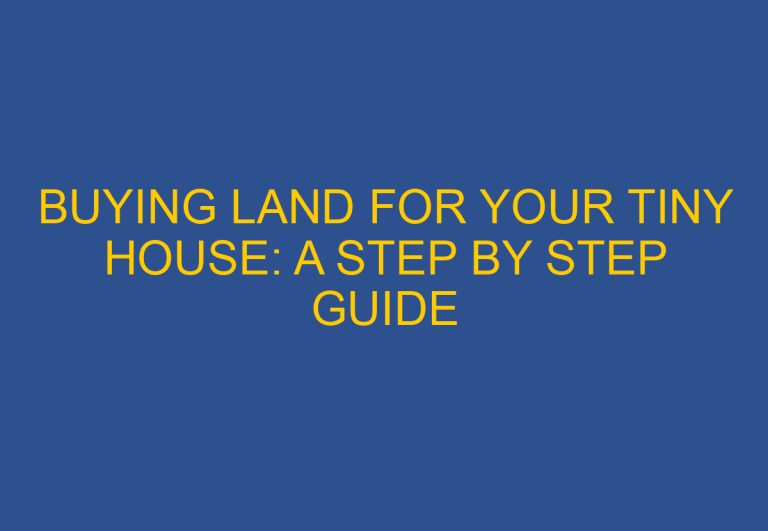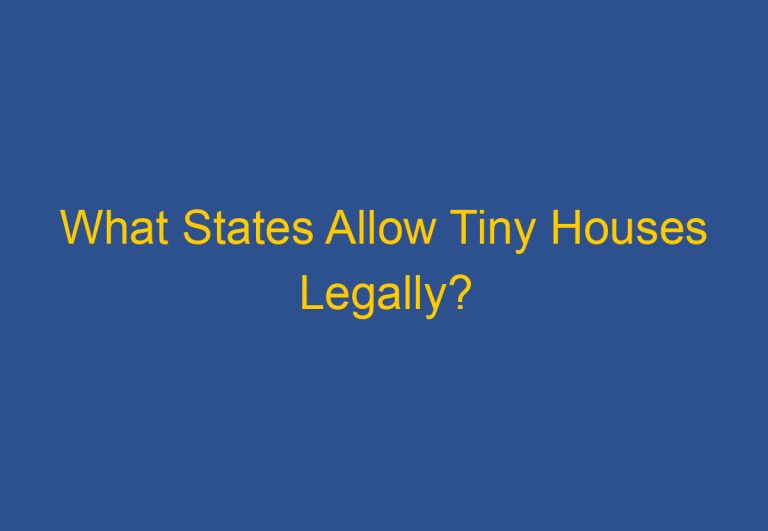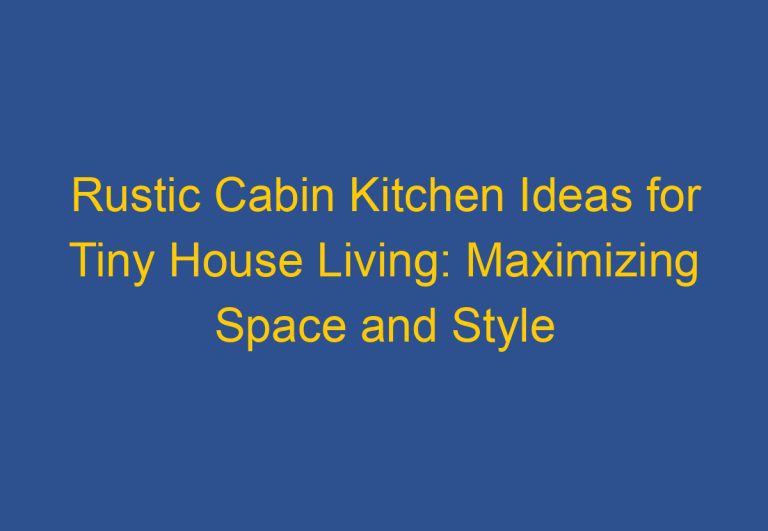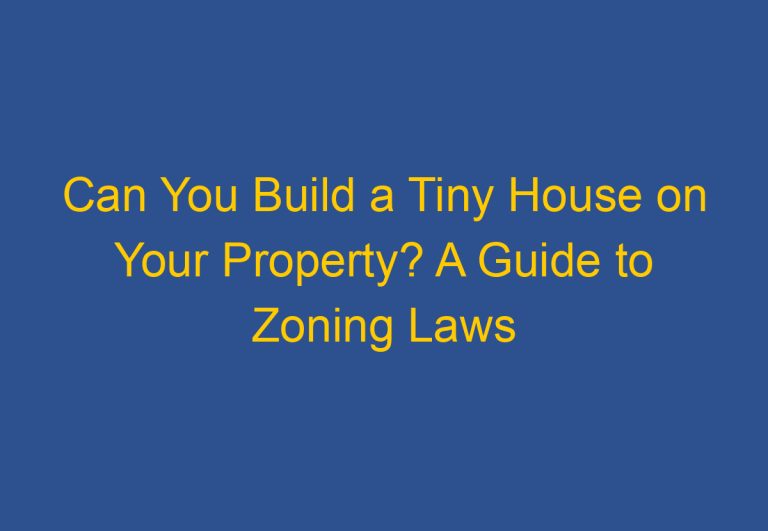Can You Finance a Tiny House? Exploring Your Options
Tiny houses have become increasingly popular in recent years, as more people seek to downsize and simplify their lives. However, many people wonder if it’s possible to finance a tiny house. The answer is yes, but the process can be a bit more complicated than financing a traditional home.
One of the main challenges with financing a tiny house is that they are often considered personal property rather than real estate. This means that they may not qualify for a traditional mortgage, which is designed for real estate. However, there are other options available, such as personal loans, RV loans, and home equity loans.
Another factor to consider when financing a tiny house is the cost. While tiny houses are generally less expensive than traditional homes, they can still be a significant investment. According to the Tiny Life blog, the average cost of a DIY tiny house is between $10,000 and $30,000, while a professionally built tiny house can cost upwards of $100,000. It’s important to carefully consider your budget and financing options before embarking on a tiny house project.
Understanding Tiny House Financing
When it comes to financing a tiny house, there are several options available that can help you achieve your dream of owning a tiny home. Understanding the different types of financing available and the eligibility requirements can help you make an informed decision about which option is best for you.
Types of Financing Available
There are several financing options available for tiny homes, including personal loans, RV loans, traditional mortgages, home equity loans, lines of credit, and collateral loans. Personal loans are a popular option for those looking to finance a tiny home. They are unsecured loans that can be used for a variety of purposes, including purchasing a tiny home. Online lenders like SoFi and Upstart offer personal loans with competitive rates and flexible repayment terms.
RV loans are another option for financing a tiny home. These loans are specifically designed for recreational vehicles and can be used to finance a tiny home on wheels. The downside of RV loans is that they typically have higher interest rates and shorter repayment terms than traditional mortgages.
Traditional mortgages are another option for financing a tiny home. However, most mortgage lenders have minimum loan amounts that exceed the cost of a tiny home, making it difficult to qualify for a mortgage for a tiny home. Home equity loans and lines of credit are also options for financing a tiny home. These loans allow you to borrow against the equity in your home to finance a tiny home. Collateral loans are secured loans that require you to put up collateral, such as a car or other asset, to secure the loan.
Eligibility and Requirements
To qualify for financing for a tiny home, you will need to meet certain eligibility requirements. These requirements can vary depending on the type of financing you are seeking. For personal loans and RV loans, you will typically need a good credit score and a steady source of income. Lenders will also look at your debt-to-income ratio and your credit history to determine your creditworthiness.
For traditional mortgages and home equity loans, you will need to have a good credit score and a steady source of income. You will also need to have enough equity in your home to qualify for a home equity loan or line of credit. Collateral loans require you to have collateral to secure the loan.
When considering financing for a tiny home, it is important to shop around and compare rates and terms from different lenders. Look for lenders that specialize in tiny home financing or RV loans, as these lenders may have more flexible loan options and repayment terms. Additionally, consider working with a lender that offers autopay, as this can help you save money on interest and make your payments more manageable.
Practical Considerations for Tiny House Ownership
Choosing the Right Tiny House
When it comes to choosing the right tiny house, there are a lot of factors to consider. The first thing to think about is what size you need. Tiny houses can range from 100 to 400 square feet, so it’s important to think about how much space you need to live comfortably. You should also consider the amenities you want in your tiny home, such as a kitchen and bathroom.
Another important factor to consider is the materials used to build the tiny house. Some builders use eco-friendly materials, while others may use more traditional building materials. You should also think about whether you want to build the tiny house yourself or have a contractor build it for you.
Navigating Legal and Zoning Challenges
One of the biggest challenges of owning a tiny house is navigating legal and zoning regulations. In some areas, it may be difficult to find a place to park your tiny house. You should research zoning laws in your area to make sure you can legally live in a tiny house.
Another challenge is finding a permanent foundation for your tiny house. Some areas require tiny houses to be on a permanent foundation, while others allow them to be on wheels. You should also consider whether you want to upgrade your tiny house in the future, as this may affect zoning regulations.
Long-Term Financial Planning
When it comes to financing a tiny house, there are a few options available. Personal loans, home equity loans, and builder financing are all options to consider. However, it’s important to keep in mind that minimum loan amounts may disqualify tiny homes from getting a traditional mortgage loan.
It’s also important to consider long-term financial planning when owning a tiny house. While tiny houses are generally more affordable than traditional homes, there may be hidden costs to consider. Monthly payments, interest rates, and down payments should all be factored into your financial plan. Additionally, if you have bad credit, you may have difficulty securing financing for a tiny house.
Overall, owning a tiny house can be a great way to simplify your life and reduce your environmental footprint. However, it’s important to carefully consider all of the practical considerations before making the decision to live in a tiny house.
Frequently Asked Questions
What are the financing options available for a tiny house?
Financing options for a tiny house include personal loans, RV loans, and home equity loans. Personal loans are the most common way to finance a tiny house, and they offer flexibility in terms of loan amount and repayment period. RV loans are also an option, but they may require a higher credit score and a larger down payment.
What credit score is typically required to finance a tiny house?
The credit score required to finance a tiny house depends on the lender and the type of loan. Personal loans may require a credit score of at least 600, while RV loans may require a score of 700 or higher. Home equity loans typically require a score of 620 or higher.
Are there any lenders that specialize in tiny house financing?
Yes, there are lenders that specialize in tiny house financing. These lenders understand the unique challenges and specifications of tiny house financing and can provide tailored loan options. Research and contact these lenders to find the best fit for your needs.
Can you use an RV loan to finance a tiny house?
Yes, you can use an RV loan to finance a tiny house, as long as the tiny house meets the requirements for an RV. These requirements include a bathroom, kitchen, and sleeping area, among others.
Is it possible to finance a tiny house with a low down payment?
Yes, it is possible to finance a tiny house with a low down payment. Personal loans may require no down payment, while RV loans may require a down payment of 10% to 20% of the purchase price. Home equity loans may require a down payment of 20% or more.
How does the financing process for a tiny house differ from traditional home loans?
The financing process for a tiny house differs from traditional home loans in several ways. Tiny houses are often considered personal property, rather than real estate, which means they may be financed with a personal loan or RV loan, rather than a traditional mortgage. Additionally, the loan amounts for tiny houses are typically smaller than those for traditional homes, and the repayment periods may be shorter.










